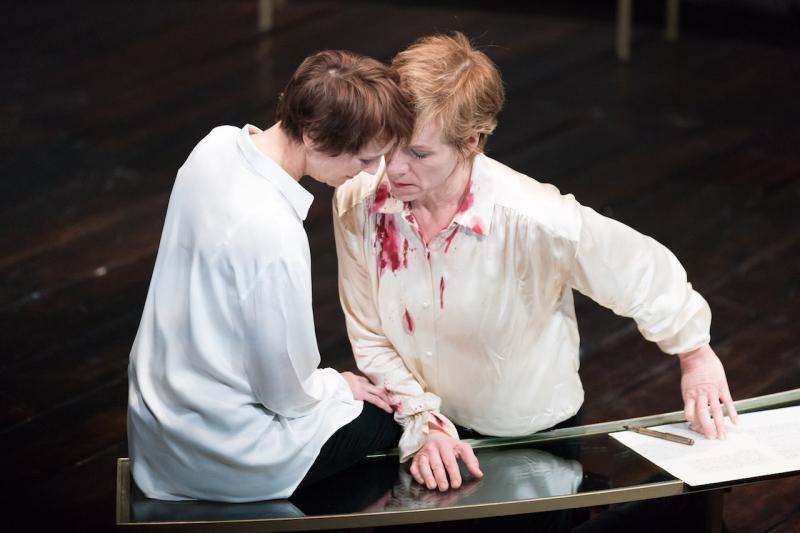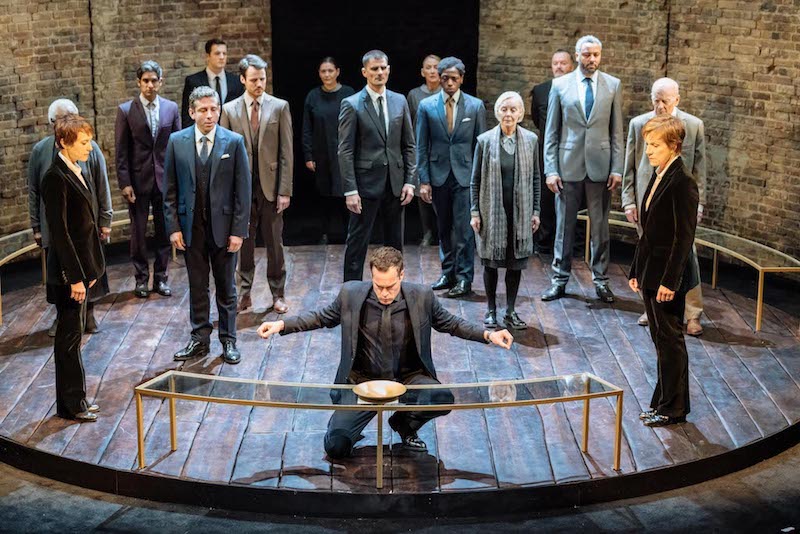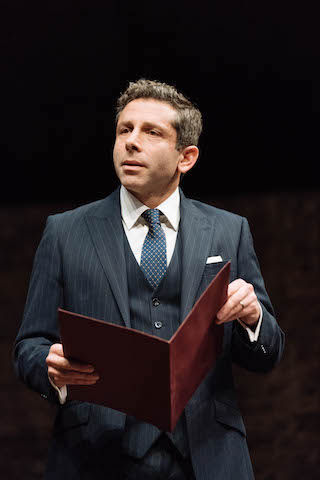Mary Stuart, Duke of York's Theatre review - superb teamwork from Juliet Stevenson and Lia Williams in Schiller's thriller | reviews, news & interviews
Mary Stuart, Duke of York's Theatre review - superb teamwork from Juliet Stevenson and Lia Williams in Schiller's thriller
Mary Stuart, Duke of York's Theatre review - superb teamwork from Juliet Stevenson and Lia Williams in Schiller's thriller
Robert Icke's production reaches the West End with Juliet Stevenson and Lia Williams tossing a coin to see who plays which queen

Casting decisions do not usually make gripping theatre. But in Robert Icke’s version of Friedrich Schiller’s 1800 political thriller, newly transferred from the Almeida to the West End, settling the question of which of two actresses will play the title role and which her nemesis, Elizabeth I, is an edge-of-the-seat moment night after night. Heads or tails? Before the entire assembled cast, the spin of a coin (a sovereign, of course) decides it. And with the result shown on screens that flank the stage, the audience is the first to know.
At Wednesday’s matinée, Lia Williams loses the call (pictured below), and in a blink the supporting cast have dropped to one knee in reverence to her opposite, Juliet Stevenson. The removal of Williams from the stage – brutally stripped of her jacket and shoes – follows swiftly. At the point the play begins, Mary has already spent 19 years as a prisoner, incarcerated at bleak Fotheringay Castle for fear that she will lead a Catholic revolt and usurp the English throne. That silver sovereign isn’t just a useful way of keeping the production fresh and the cast on its toes. It’s also a metaphor for Schiller’s treatment of these two remarkable figures from history. Despite their obvious differences – Catholic/Protestant, four-times-married/virgin queen – the play reveals them to be two sides of the same coin.
That silver sovereign isn’t just a useful way of keeping the production fresh and the cast on its toes. It’s also a metaphor for Schiller’s treatment of these two remarkable figures from history. Despite their obvious differences – Catholic/Protestant, four-times-married/virgin queen – the play reveals them to be two sides of the same coin.
Icke’s production amplifies this by giving them identical mannish haircuts and velvet trouser suits. Both have to fight to hold their own in a man’s world. Both are passionate, intelligent, acutely aware of the random accidents of birth that placed them at opposite poles on the political spectrum, yet which also made them kin. One is imprisoned by high walls, the other by royal status, “a prison cell with jewels”. Thanks to the alternating casting, they conceivably are, in Mary’s words, “sister queens” who intimately know each other’s minds.
Yet, as an account of events as they happened, Schiller’s text is unlikely to help anyone pass their History GCSE. Not only does he use speculative gossip as a key engine of the plot (the Earl of Leicester’s romantic entanglement with both queens, no less), but he imagines a major event that certainly did not happen. Yet so brilliantly does he dramatise the fanciful face-to-face encounter between the two women that a poetic truth emerges.
The same might be said of the added tissues of fiction in Icke’s production, which is very much a “version” rather than a translation. In the moments before her execution, as Mary prepares to meet her maker, she receives the last rites from a secretly ordained priest – here played a woman. Icke clearly wanted to contrast the warm, female support around the doomed but radiantly resigned Mary with the chilly male courtiers who leave Elizabeth high and dry to bear the guilt of regicide. A female priest is surely no more unlikely a sight on a London stage than an Afro-Caribbean courtier, yet interestingly it triggered what sounded like barely stifled disbelief around the stalls.
 Elsewhere, too, Icke finds contemporary resonance in spades. Just because a thing is popular, does that make it right? This is the crux of Elizabeth’s dilemma. The duplicity and back-stabbing among Elizabeth’s courtiers are pretty familiar too. Icke has one of them describe another’s actions as “flip-flopping” to drive home the point.
Elsewhere, too, Icke finds contemporary resonance in spades. Just because a thing is popular, does that make it right? This is the crux of Elizabeth’s dilemma. The duplicity and back-stabbing among Elizabeth’s courtiers are pretty familiar too. Icke has one of them describe another’s actions as “flip-flopping” to drive home the point.
While it’s easy to laud the female leads in this production – Stevenson and Williams are equally affecting in their steel and vulnerability – it’s harder to love the supporting men (roughly half of them new to this transfer). Trussing them in tight-fitting, single-buttoned suits gives them a physical awkardness that is almost certainly intended. In Elizabeth’s day, of course, they would have vied with each other to sport the most flamboyant cuff or ruff. Instead, that rivalry shows itself in oily manners and a nervy awareness, every time each of them opens his mouth in Elizabeth’s presence, that it could either make or break him.
Elliot Levey (new to the cast, pictured above) is superb as Elizabeth’s advisor-in-chief Lord Burleigh, a man who cloaks his hatred of Catholics in seeming reasonableness, and whose cocky “I know more than I’m telling” rise of the eyebrow on every exit becomes increasingly chilling. John Light grows convincingly frantic as his own multiply double-crossing plots begin to ensnare him, while by contrast Michael Byrne’s ancient Yorkshireman Lord Talbot is a lone voice of genuine kindness in Elizabeth’s ear.
Hildegard Bechtler’s bare set has transferred well, its doubled curve of brick castle wall looking suitably permanent and stark at the Duke of York’s – you almost feel its winter chill. Yet the extravagant closing sight of Gloriana in her pomp is just as savage. This is a piece of theatre that lets no one off lightly. Even Paul Arditti’s sound design, a persistent low hum of tone clusters, seems designed to make you ultimately want to howl.
- Mary Stuart at the Duke of York's Theatre until 31 March
- Read the review of the original Almeida production, which covers both sets of performances from a matinee and an evening perspective
- Read more theatre reviews on theartsdesk
Overleaf: Robert Icke's dazzling career so far
Casting decisions do not usually make gripping theatre. But in Robert Icke’s version of Friedrich Schiller’s 1800 political thriller, newly transferred from the Almeida to the West End, settling the question of which of two actresses will play the title role and which her nemesis, Elizabeth I, is an edge-of-the-seat moment night after night. Heads or tails? Before the entire assembled cast, the spin of a coin (a sovereign, of course) decides it. And with the result shown on screens that flank the stage, the audience is the first to know.
At Wednesday’s matinée, Lia Williams loses the call (pictured below), and in a blink the supporting cast have dropped to one knee in reverence to her opposite, Juliet Stevenson. The removal of Williams from the stage – brutally stripped of her jacket and shoes – follows swiftly. At the point the play begins, Mary has already spent 19 years as a prisoner, incarcerated at bleak Fotheringay Castle for fear that she will lead a Catholic revolt and usurp the English throne. That silver sovereign isn’t just a useful way of keeping the production fresh and the cast on its toes. It’s also a metaphor for Schiller’s treatment of these two remarkable figures from history. Despite their obvious differences – Catholic/Protestant, four-times-married/virgin queen – the play reveals them to be two sides of the same coin.
That silver sovereign isn’t just a useful way of keeping the production fresh and the cast on its toes. It’s also a metaphor for Schiller’s treatment of these two remarkable figures from history. Despite their obvious differences – Catholic/Protestant, four-times-married/virgin queen – the play reveals them to be two sides of the same coin.
Icke’s production amplifies this by giving them identical mannish haircuts and velvet trouser suits. Both have to fight to hold their own in a man’s world. Both are passionate, intelligent, acutely aware of the random accidents of birth that placed them at opposite poles on the political spectrum, yet which also made them kin. One is imprisoned by high walls, the other by royal status, “a prison cell with jewels”. Thanks to the alternating casting, they conceivably are, in Mary’s words, “sister queens” who intimately know each other’s minds.
Yet, as an account of events as they happened, Schiller’s text is unlikely to help anyone pass their History GCSE. Not only does he use speculative gossip as a key engine of the plot (the Earl of Leicester’s romantic entanglement with both queens, no less), but he imagines a major event that certainly did not happen. Yet so brilliantly does he dramatise the fanciful face-to-face encounter between the two women that a poetic truth emerges.
The same might be said of the added tissues of fiction in Icke’s production, which is very much a “version” rather than a translation. In the moments before her execution, as Mary prepares to meet her maker, she receives the last rites from a secretly ordained priest – here played a woman. Icke clearly wanted to contrast the warm, female support around the doomed but radiantly resigned Mary with the chilly male courtiers who leave Elizabeth high and dry to bear the guilt of regicide. A female priest is surely no more unlikely a sight on a London stage than an Afro-Caribbean courtier, yet interestingly it triggered what sounded like barely stifled disbelief around the stalls.
 Elsewhere, too, Icke finds contemporary resonance in spades. Just because a thing is popular, does that make it right? This is the crux of Elizabeth’s dilemma. The duplicity and back-stabbing among Elizabeth’s courtiers are pretty familiar too. Icke has one of them describe another’s actions as “flip-flopping” to drive home the point.
Elsewhere, too, Icke finds contemporary resonance in spades. Just because a thing is popular, does that make it right? This is the crux of Elizabeth’s dilemma. The duplicity and back-stabbing among Elizabeth’s courtiers are pretty familiar too. Icke has one of them describe another’s actions as “flip-flopping” to drive home the point.
While it’s easy to laud the female leads in this production – Stevenson and Williams are equally affecting in their steel and vulnerability – it’s harder to love the supporting men (roughly half of them new to this transfer). Trussing them in tight-fitting, single-buttoned suits gives them a physical awkardness that is almost certainly intended. In Elizabeth’s day, of course, they would have vied with each other to sport the most flamboyant cuff or ruff. Instead, that rivalry shows itself in oily manners and a nervy awareness, every time each of them opens his mouth in Elizabeth’s presence, that it could either make or break him.
Elliot Levey (new to the cast, pictured above) is superb as Elizabeth’s advisor-in-chief Lord Burleigh, a man who cloaks his hatred of Catholics in seeming reasonableness, and whose cocky “I know more than I’m telling” rise of the eyebrow on every exit becomes increasingly chilling. John Light grows convincingly frantic as his own multiply double-crossing plots begin to ensnare him, while by contrast Michael Byrne’s ancient Yorkshireman Lord Talbot is a lone voice of genuine kindness in Elizabeth’s ear.
Hildegard Bechtler’s bare set has transferred well, its doubled curve of brick castle wall looking suitably permanent and stark at the Duke of York’s – you almost feel its winter chill. Yet the extravagant closing sight of Gloriana in her pomp is just as savage. This is a piece of theatre that lets no one off lightly. Even Paul Arditti’s sound design, a persistent low hum of tone clusters, seems designed to make you ultimately want to howl.
- Mary Stuart at the Duke of York's Theatre until 31 March
- Read the review of the original Almeida production, which covers both sets of performances from a matinee and an evening perspective
- Read more theatre reviews on theartsdesk
Overleaf: Robert Icke's dazzling career so far
The future of Arts Journalism
You can stop theartsdesk.com closing!
We urgently need financing to survive. Our fundraising drive has thus far raised £49,000 but we need to reach £100,000 or we will be forced to close. Please contribute here: https://gofund.me/c3f6033d
And if you can forward this information to anyone who might assist, we’d be grateful.

Subscribe to theartsdesk.com
Thank you for continuing to read our work on theartsdesk.com. For unlimited access to every article in its entirety, including our archive of more than 15,000 pieces, we're asking for £5 per month or £40 per year. We feel it's a very good deal, and hope you do too.
To take a subscription now simply click here.
And if you're looking for that extra gift for a friend or family member, why not treat them to a theartsdesk.com gift subscription?
more Theatre
 That Bastard, Puccini!, Park Theatre review - inventive comic staging of the battle of the Bohèmes
James Inverne enjoyably reconstructs the rivalry between Puccini and Leoncavallo
That Bastard, Puccini!, Park Theatre review - inventive comic staging of the battle of the Bohèmes
James Inverne enjoyably reconstructs the rivalry between Puccini and Leoncavallo
 Till the Stars Come Down, Theatre Royal Haymarket review - a family hilariously and tragically at war
Beth Steel makes a stirring West End debut with her poignant play for today
Till the Stars Come Down, Theatre Royal Haymarket review - a family hilariously and tragically at war
Beth Steel makes a stirring West End debut with her poignant play for today
 Nye, National Theatre review - Michael Sheen's full-blooded Bevan returns to the Olivier
Revisiting Tim Price's dream-set account of the founder of the health service
Nye, National Theatre review - Michael Sheen's full-blooded Bevan returns to the Olivier
Revisiting Tim Price's dream-set account of the founder of the health service
 Girl From The North Country, Old Vic review - Dylan's songs fail to lift the mood
Fragmented, cliched story rescued by tremendous acting, singing and music
Girl From The North Country, Old Vic review - Dylan's songs fail to lift the mood
Fragmented, cliched story rescued by tremendous acting, singing and music
 The Merry Wives of Windsor, Shakespeare's Globe review - hedonistic fizz for a summer's evening
Emma Pallant and Katherine Pearce are formidable opponents to Falstaff's buffoonery
The Merry Wives of Windsor, Shakespeare's Globe review - hedonistic fizz for a summer's evening
Emma Pallant and Katherine Pearce are formidable opponents to Falstaff's buffoonery
 Run Sister Run, Arcola Theatre review - emphatic emotions, overwrought production
Chloë Moss’s latest play about the different lives of two sisters is deeply felt
Run Sister Run, Arcola Theatre review - emphatic emotions, overwrought production
Chloë Moss’s latest play about the different lives of two sisters is deeply felt
 Intimate Apparel, Donmar Warehouse review - stirring story of Black survival in 1905 New York
An early Lynn Nottage work gets a superb cast and production
Intimate Apparel, Donmar Warehouse review - stirring story of Black survival in 1905 New York
An early Lynn Nottage work gets a superb cast and production
 Hercules, Theatre Royal Drury Lane review - new Disney stage musical is no 'Lion King'
Big West End crowdpleaser lacks punch and poignancy with join-the-dots plotting and cookie-cutter characters
Hercules, Theatre Royal Drury Lane review - new Disney stage musical is no 'Lion King'
Big West End crowdpleaser lacks punch and poignancy with join-the-dots plotting and cookie-cutter characters
 Showmanism, Hampstead Theatre review - lip-synced investigation of words, theatricality and performance
Technically accomplished production with Dickie Beau never settles into a coherent whole
Showmanism, Hampstead Theatre review - lip-synced investigation of words, theatricality and performance
Technically accomplished production with Dickie Beau never settles into a coherent whole
 4.48 Psychosis, Royal Court review - powerful but déjà vu
Sarah Kane’s groundbreaking play gets a nostalgic anniversary reboot
4.48 Psychosis, Royal Court review - powerful but déjà vu
Sarah Kane’s groundbreaking play gets a nostalgic anniversary reboot

Add comment